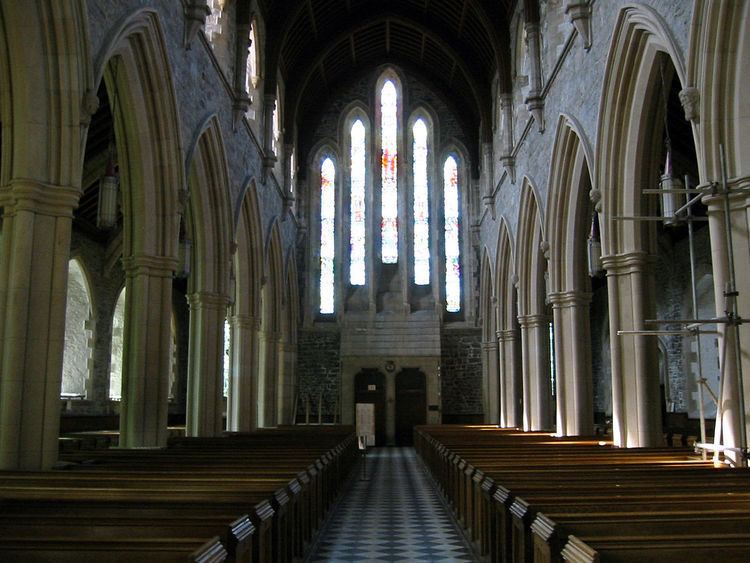Nationality Scottish Canadian Died May 30, 1888 Role Architect | Name William Hay Occupation Architect | |
 | ||
Buildings Cathedral of the Most Holy Trinity, Bermuda Structures St Basil's Church - Toronto, St Giles' Cathedral, Cathedral of the Most Holy Trini Similar People William Morris, Edward Burne‑Jones, John the Baptist, Basil of Caesarea, Saint Giles | ||
William Hay (17 May 1818 – 30 May 1888) was a Scottish architect who was actively working internationally from 1842 to 1887. A specialist in gothic architecture, he is primarily known for his work on several churches and cathedrals. His most famous structure is the Bermuda Cathedral in Hamilton, Bermuda which he designed in 1885. Construction of the cathedral began in 1886 and was completed seven years after Hay's death in 1905. He also designed some of the oldest buildings and structures in Toronto, Ontario, from 1853–1861, and was responsible for the restoration of St. Giles' Cathedral in Edinburgh from 1872–1884. His career exemplifies how the British Empire of the Victorian Era was united not only by military and political strength but also by professionals who took advantage of opportunities in its wide array of territories.
Contents
Early life: 1818–1841
Born at Dykeside, Peterhead, Hay was named after his father, who was a Scottish Episcopalian grain merchant. In his youth he was apprenticed to a joiner, but an accident during a job at Ellishill House, which broke his leg, ended his career in this area. The doctor treating him for his injury encouraged him to study architecture during his recovery and his career accordingly took a turn in that direction.
Early career: 1842–1861
Hay tackled his first job as an architect at the age of 24 with the St James Episcopal Church in Cruden Bay in 1842–1843. He married his first wife, Janet Reid (1819–1860), in 1844, and that same year relocated to Edinburgh to become an assistant to architect John Henderson.
After working with Henderson for two years, Hay moved to London to apprentice with George Gilbert Scott in 1846. Scott entrusted him with overseeing the building of the nave of the Cathedral of St. John the Baptist in St. John's, Newfoundland. For that project he travelled throughout England and Scotland in late 1846 and early 1847 to acquire materials and skilled craftsmen. In April 1847 he, along with his wife and her brother Thomas (their ward), sailed to Newfoundland. He remained there until the nave was completed in 1850.
Hay spent some time in his native town working in 1850–1853, building there St. John's Episcopal Church, Longside and a house at No 22 Broad Street for his mother, Jean Hay (née Alexander). During this time he considered setting up practice in either Montreal, Canada East, or Chicago, Illinois, and made visits to those cities. He ultimately settled on establishing his practice in Toronto, and accordingly moved there in late 1853. He remained in that city until late 1861, following the sudden death of his wife, who never bore children, in 1860.
While in Toronto, Hay developed a highly successful architecture firm which he left to his recently acquired partner, Thomas Gundry. His apprentice Henry Langley became Gundry's new partner upon his departure. In Toronto he designed the Toronto General Hospital (1855), St. Basil's Church, Toronto (1855–1856), the House of Providence (1855–1858), two of the original buildings at the University of St. Michael's College (1856), the school addition to the Church of the Holy Trinity (1858), the Yorkville Town Hall (1859–1860), and the Oaklands at De La Salle College (1860) among other structures. He also served on the council of the Royal Canadian Institute (1858–1860), was the Vice-President of the Toronto Mechanics' Institute (1859–1861), and was Secretary of the Association of Architects Civil Engineers and Provincial Surveyors of Canada.
Later career: 1862–1888
After some time spent in Scotland in 1861, Hay spent the year 1862 in Bermuda consulting on problems developed during the building of the first Cathedral of the Most Holy Trinity in Hamilton. He had previously been consulted in 1848–1849 for work on the cathedral by Bishop Reid; having reviewed James Cranston of Oxford's 1844 designs for the structure. He had made several alterations to those plans at that time, but the building of the cathedral had not commenced until several years later. The cathedral was completed in 1869 but was destroyed by arson in 1884. Hay was approached at that time to design the current Bermuda Cathedral in the neo-Gothic style. Built between 1886-1905, it was his last significant work and his most famous.
In 1862 Hay formed a partnership with architect David Stirling in Halifax, Nova Scotia. They worked together through 1865 on the Halifax Club (1862), Alexander Keith's residence (1863), and a new Provincial Building designed for use as a post office, customs house, and railway department (built from 1863–1868, now the Art Gallery of Nova Scotia). He married his second wife, Jemima Huddleston (1838-1905) of Ryde, Isle of Wight, in 1864. The couple produced one daughter, Fanny, and settled in Edinburgh where Hay set up a new practice.
In 1871 he was hired by Sir William Chambers, Lord Provost of Edinburgh, to oversee the restoration of St. Giles' Cathedral which took place from 1872-1884. In 1877 he formed a partnership with John Henderson's son George Henderson. The two men worked together until Hay became seriously ill in October 1887. He died eight months later at Rabbit Hall, Hamilton Street, Joppa at the age of 70.
